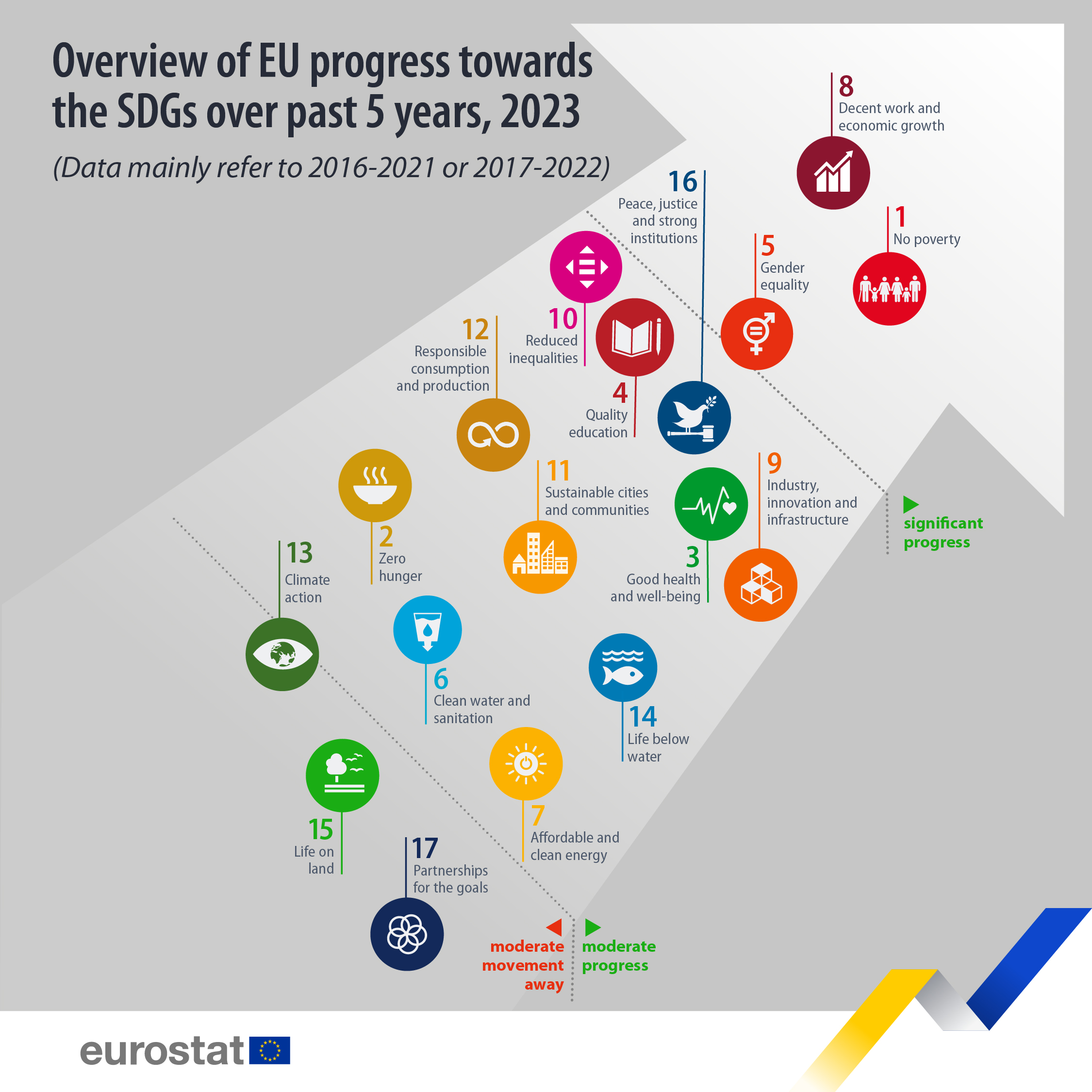How has the EU progressed towards the SDGs?

Eurostat issues today the publication ‘Sustainable development in the European Union — monitoring report on progress towards the SDGs in an EU context, 2023 edition’, which provides a statistical overview of progress towards the Sustainable Development Goals (SDGs) in the EU. The report focuses on the trends over the past five years, which means that data refer to the periods up to 2021 and 2022.
The Eurostat monitoring report shows that the EU has progressed strongly towards many socio-economic goals over the most recent five-year period of available data, while trends in the environmental domain have been less favourable.
EU made significant progress toward 3 SDGs: decent work and economic growth, reducing poverty and improving gender equality
Over the past five years, the EU made significant progress towards ensuring decent work and economic growth (SDG 8), reducing poverty (SDG 1) and improving gender equality (SDG 5).
There was also good progress towards reducing inequalities (SDG 10), ensuring quality education (SDG 4) and fostering peace and personal security within the EU’s territory and improving access to justice and trust in institutions (SDG 16). The EU has also seen good progress towards the goals of health and well-being (SDG 3) despite the setbacks caused by the COVID-19 pandemic, and on innovation and infrastructure (SDG 9).
In comparison, progress towards the remaining six goals was less significant. Trends in the areas of responsible consumption and production (SDG 12), sustainable cities and communities (SDG 11), life below water (SDG 14), zero hunger (SDG 2), clean water and sanitation (SDG 6) and affordable and clean energy (SDG 7) were moderately favourable for the EU.
More progress is expected for three goals: climate action (SDG 13), life on land (SDG 15) and global partnerships (SDG 17).
In the case of SDG 13, according to provisional estimates for 2021, the EU has reduced its net greenhouse gas emissions by about 30% since 1990. However, the EU has set ambitious and unparalleled climate targets for 2030, and, compared with past trends, they will require more effort. For this reason, additional measures were already put in place through the 'Fit for 55 package'. For energy, the EU has also set more ambitious targets for 2030, implying that stronger progress is expected to be visible in the coming years in energy efficiency and renewable energies.
Concerning life on land (SDG 15), even though terrestrial protected areas have increased since 2013, additional efforts are needed to reverse the degradation of ecosystems.
Regarding partnerships for the goals (SDG 17), the trend partially reflects cyclical effects and, notably, the increase in public debt resulting from the COVID-19 crisis.
Improved analysis of short-term effects of the current crisis on the SDGs
For the first time, the report analysed the short-term impact of the current crises on the SDGs. This includes the energy crisis brought about by Russia’s aggression against Ukraine and the aftershocks of the pandemic. The report also features a chapter with an improved analysis of the spillover effects of EU consumption in the rest of the world.
The EU SDGs indicators set is structured along 17 goals, with around 100 indicators, reviewed every year, aligned but not identical to the UN SDG indicators. Many of the indicators are already used to monitor existing policies as the 8th Environment Action Programme and the European Pillar of Social Rights Action Plan.
Join us for the webinar
If you are interested in finding out more about the EU’s progress towards the goals, join us tomorrow, 25 May, at 10 AM for an online briefing on the “Sustainable Development Goals (SDGs) - monitoring report - 2023 edition”.
The online webinar will be streamed on the Eurostat website and Eurostat Facebook account. It is open to anyone interested, and there is no need to register. There will be an opportunity to ask questions via Slido.
Add the event to your calendar by clicking below, and join us.
Add to Calendar Add to Google Calendar Add to Yahoo! Calendar
For more information
- Sustainable development in the European Union - monitoring report on progress towards the SDGs in an EU context, 2023 edition
- Sustainable development in the European Union — Statistical annex to the EU voluntary review — 2023 edition
- Visualisation tool "SDGs & me"
- Visualisation tool “SDG country overview”
- Statistics Explained articles on Sustainable development in the EU
- Thematic section on the EU Sustainable development indicators
- Database on the EU Sustainable development indicators
- "Next steps for a sustainable European future – European action for sustainability": communication from the Commission.
- European Commission Priorities for 2019-2024
- The European Green Deal
- UN webpage dedicated to the 2030 Agenda for Sustainable Development
Methodology notes
- Methodology for assessing indicator trends is explained in Annex I of the report.
If you have any queries, please visit our contact us page.

